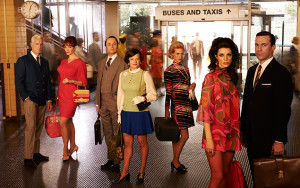
The finale of Mad Men is the talk of the town. It’s hardly surprising—Entertainment Weekly has called the show, “the TV-taste status symbol of the moment.”
So what is everyone saying? In a tribute to Mad Men’s impact on its industry, Ad Week quotes Stuart Elliott, the recently retired New York Times advertising columnist: “Half of the people I talk to from that era are very hard-core fans of the show and say that it is exactly what it was like then. And half say the show was completely phony and drummed up for dramatic purposes.”
I’ve thought a lot about the specifics of the Mad Men era—it is the setting for the novel I am currently writing—and I find myself with a foot in both camps. While there are times when details or situations seem exaggerated for dramatic effect, overall, the show is wonderfully evocative of my early days in New York.
“The boys in the bullpen”
In 1964, just out of Rhode Island School of Design, I was determinately in search of a job as an assistant art director in New York.The women in my class had been warned that, despite being artists, we would likely have to start (and hopefully not get trapped) as someone’s secretary. I vowed that would never happen, and it didn’t. But I interviewed extensively before being hired as assistant to the art director at Bride’s magazine.
At one large ad agency I was informed they couldn’t possibly hire me because “the boys in the bullpen,” where all assistants typically began, would feel inhibited about cursing in front of a girl and, as a result, their work would suffer. The bearer of this news was a senior partner at the agency and the perfect image of the Mad Man of the era. At the time I didn’t even realize I had been discriminated against; I doubt the word was even in my vocabulary.
Sexy and sexist
In the mid 1960s, hemlines were rising rapidly and all the young women I knew and worked with shortened their dresses on an almost monthly basis. Each time I see Peggy, I’m dismayed at her outfits. The girls walking by in the hallways are far more representative of the time than the women with speaking parts, who by the way, seem to be based on Barbie dolls. I have no recall of anyone, especially of Peggy’s age, repressed or not, dressing quite like her. While the older women I knew, mostly editors and writers, dressed conservatively, they were far more stylish and never looked as dowdy as Peggy.
Since the show began, I’ve had many people ask me about the sexism. While it’s a fact that men’s attitudes towards women were condescending, I never experienced anything like what happens to Joan, nor did I know anyone who encountered anything so blatantly overt. True, Joan’s an imposing and sexy figure, but the mean spirited jibes she receives are exaggerated. That men spoke that way was, and is still, obvious. I heard plenty of innuendos, though nothing so extreme as Joan’s treatment by the men at her meeting (with Peggy) at McCann. Nevertheless, as in Joan’s meeting with the president of McCann, it is true that they were routinely chauvinistic, crass and dismissive.
Most of us managed to shake off unpleasant remarks with humor. One of my bosses at a fashion magazine liked to walk potential advertisers past the art department whispering, “Have a look at my art director.” Did he think I didn’t hear him? And yet we kept our comments to ourselves. There was no other way; men were in charge. That said, they could be easily influenced: in those years, I wore mini skirts whenever I was interviewing with a man, and more often than not, all presentations being equal, I got the job. (My apology to feminists.)
The advertising business was at its creative peak in the 1960s and Mad Men portrays it well. For me, the “Lost Horizon” episode that aired on May 3rd could have been a perfect ending: Roger and Peggy alone in their shattered and abandoned office blitzed on Vermouth. Roger zoned out and playing the organ as Peggy, with unexpected grace, circles him on roller skates. A surreal scene for a surreal story of a surreal profession.
Leave a Reply